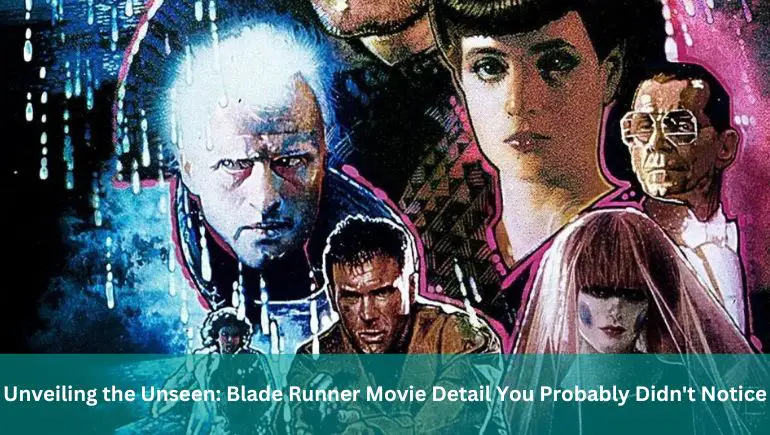In Blade Runner, a detail you probably didn’t notice is the recurrent motif of eyes, symbolizing both humanity and surveillance. This theme is subtly woven into the film, revealing deeper layers of meaning.
Blade Runner explores the blurry line between humans and replicants, highlighting our obsession with identity and what makes us human. Through the use of close-ups and reflections, the film invites viewers to question their own sense of self.
Additionally, the eyes serve as a visual representation of surveillance, hinting at the pervasive control exerted by corporations and governments.
These small but significant details enhance the overall viewing experience, making Blade Runner a thought-provoking and visually captivating film.
The Hidden Symbolism In The Opening Sequence
Blade Runner, a cult favorite movie, contains subtle details and hidden symbolism that often go unnoticed by viewers. One such detail is the eye motif portrayed in the opening sequence. This motif carries significant meaning, representing the human condition and providing a foreshadowing of future plot points.
By focusing on the eye, the film suggests how human perception and understanding of reality can be deceiving. The eye becomes a symbol of both vulnerability and power, illustrating the duality of the characters and the complexity of their actions.
As the movie delves deeper into its intricate narrative, these initial visual cues lay the foundation for a thought-provoking exploration into the blurred lines between humans and replicants. Through its attention to subtle details, Blade Runner captivates its audience and invites them to question the very essence of what it means to be human.
The Subtle References To Film Noir
Blade Runner, a cult classic, hides subtle film noir references through its expert use of lighting and shadow. The film incorporates the iconic hard-boiled detective tropes, immersing viewers in its intricate narrative. Blade Runner also pioneers the cyberpunk aesthetic, showcasing a futuristic world filled with technological advancements.
The clever play of light and shadow adds depth to the storytelling, creating a dark and mysterious atmosphere. By seamlessly merging elements of film noir with a futuristic setting, Blade Runner captivates audiences with its unique style.
This attention to detail and the incorporation of different genres make Blade Runner a visually stunning and thought-provoking film.
Enjoying this masterpiece is a constant discovery of hidden details and references that make it a truly captivating cinematic experience.
The Unnoticed Character Connections
Blade Runner is a movie with intricate details that often go unnoticed by viewers. One aspect that is particularly interesting is the connections between the characters. Many of them share backgrounds and histories, which create echoes and parallels throughout the film.
These connections have a significant impact on the development of the characters, shaping their motivations and actions. Whether it’s the shared experiences of being replicants or the consequences of their past choices, these connections contribute to the depth and complexity of the story.
Blade Runner is a cinematic masterpiece that rewards attentive viewers with a deeper understanding of the characters and their interconnectedness. So, next time you watch Blade Runner, keep an eye out for these subtle details that add layers of meaning to the film.
Read More: 10 One-Hit Wonders in the Acting World According to Fans: Unforgettable Stars Now Forgotten
Frequently Asked Questions For Blade Runner Movie Detail You Probably Didnt Notice
What Are Some Hidden Details In Blade Runner Movie?
Blade Runner movie is filled with hidden details that you might have missed. Look out for subtle references to classic literature, like the unicorn symbolizing Deckard’s humanity, or the origami figures left by Gaff that foreshadow key plot elements. These details enhance the viewing experience and add depth to the story.
How Does Blade Runner Portray The Future?
Blade Runner portrays a dystopian future where technology has advanced to create a dark and gritty society. The movie showcases futuristic elements such as flying cars, massive cityscapes, and the existence of artificially intelligent robots known as replicants.
This portrayal of the future offers a thought-provoking look into the potential consequences of rapid technological advancement.
Who Is The Main Character In Blade Runner Movie?
The main character in Blade Runner is Rick Deckard, portrayed by Harrison Ford. Deckard is a retired blade runner who is tasked with hunting down and “retiring” rogue replicants. His journey through the cyberpunk cityscape forces him to question his own humanity and the morality of his mission.
Deckard’s complex character adds depth and intrigue to the storyline.
Conclusion
In a world of complex storytelling and visually stunning films, Blade Runner stands out as a masterpiece. From its gripping narrative to its meticulous attention to detail, this movie captivates audiences with its rich and thought-provoking themes. While many have seen Blade Runner multiple times, there are still hidden gems that often go unnoticed.
The intricate set design and subtle hints sprinkled throughout the film add layers of depth and intrigue. From the significance of origami figures to the clever use of reflections, Blade Runner is a treasure trove of details waiting to be discovered.
Whether you’re a long-time fan or watching the film for the first time, take a closer look and you’ll be rewarded with a newfound appreciation for its intricate craftsmanship. Blade Runner is a timeless classic that continues to amaze and inspire, and its attention to detail is a testament to the artistry and skill of its creators.
So, the next time you watch Blade Runner, let your eyes wander and discover the hidden details in this mesmerizing cinematic experience.





